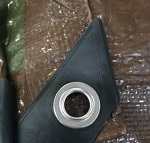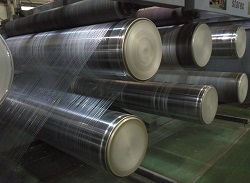
|
||
|
Products > What is Tarpaulin?A little Tarpaulin 101, courtesy of the tarpaulin experts at Puyoung. Tarpaulin, or tarp, is a heavy-duty, waterproof fabric, originally made of tarred cotton canvas and used by sailors. Today, tarps are commonly made of plastics such as polyethylene. Tarpaulin is a highly versatile fabric, and some common uses include:
Polyethylene Tarpaulin vs Other Types of TarpaulinThere are three main types of tarpaulin: canvas tarps, polyethylene (poly or PE) tarps, and vinyl (PVC) tarps. When compared with canvas tarps and vinyl tarps, poly tarps are the least expensive of the three. They are also waterproof and rot proof as opposed to canvas tarps which are only water resistant and may rot in very damp conditions. Poly tarps are a great choice for everyday use, and when UV treated they hold up well in extended outdoor use. However, they are not as durable as vinyl or canvas tarps. How to Choose a Polyethylene TarpIn addition to selecting a suitable color and size, note whether the tarp is graded light-duty, medium-duty, or heavy-duty. Technical specifications of the tarp may include:

Aluminum grommet on a Brown/Olive Green 8x8 light-duty tarp.
Important: Weight is a good metric of durability when choosing between different tarps of the same brand, but be careful when choosing between Brand A and Brand B. Don't just look at weight and choose the cheapest brand. Some manufacturers use a high percentage of fillers and recycled PE to cut costs, and this will yield a poor quality tarp even though it may be heavy. This is why it's important to go with a trusted manufacturer. Note also whether the tarp is UV resistant (UV stabilized), as most poly tarps are. If the tarp is not UV resistant, it may degrade within a few months of continued exposure to sunlight. If the tarp will be used at a construction site or close to a flame, you should also buy a flame retardant (FR) tarp. However, FR tarps are not fire proof. They will melt if continuously exposed to flame, but will not fuel the fire and facilitate combustion. FR tarps would stop burning after the source of the flame has been removed, whereas non-FR tarps could continue to burn after the flame has been removed. How is Polyethylene Tarpaulin Made?
Extrusion line producing polyethylene yarn
Most tarpaulin manufacturers start with polyethylene purchased in this pellet form. HDPE pellets are fed into an extruding line which first melts the pellets and produces polyethylene film, and then cuts and stretches the film into polyethylene yarn. A weaving loom then cross-weaves the yarn into a fabric that is tear-resistant and stretch-resistant. This fabric is then coated on both sides with a layer of low-density polyethylene (LDPE), which gives the tarpaulin a protective shiny finish, and masterbatches are used at this step to determine the color of the tarpaulin. Rolls of tarpaulin produced in this way would then be cut to size, edges reinforced with rope and welded, and grommets (the rings evenly spaced along the edges of a tarp) added to create the finished product. See tarpaulin production diagram |
 |
9F PUYOUNG BLDG. 286 GANGNAM-DAERO, GANGNAM-GU, SEOUL 06258, KOREA Copyright © 2016-2018 Puyoung. All rights reserved. |

|
 English
English
 한국어
한국어 Français
Français 日本語
日本語 简体中文
简体中文